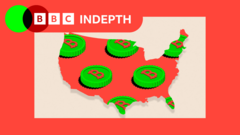The rise of AI dolls created from personal images raises significant ethical and environmental concerns that cannot be ignored.
The Concerns Behind the AI Doll Trend: Are the Risks Worth the Fun?

The Concerns Behind the AI Doll Trend: Are the Risks Worth the Fun?
As the popularity of AI-generated dolls surges, apprehensions about their implications grow.
In recent weeks, a novel trend has emerged on social media platforms: individuals transforming themselves into miniature dolls or action figures using generative AI tools, like ChatGPT. Many are uploading selfies and custom prompts to produce playful renditions of themselves, resulting in a new wave of 'mini-me' content that has captured the attention of brands and influencers alike. While the trend appears harmless and entertaining, serious discussions are unfolding surrounding its environmental impact and data privacy implications.
The process of creating these AI dolls is straightforward. Users simply upload a personal photo along with detailed instructions outlining how they want the final product to appear. From the color of the packaging to specific accessories, these adjustments allow for personalized creations—though they are not always successful. Numerous users have taken to social media to share the amusing outcomes of their AI dolls, often finding the results wildly inaccurate or cartoonishly exaggerated.
Prominent brands, including beauty companies and postal services, have embraced this trend, capitalizing on the collective enthusiasm it generates. Jasmine Enberg, an analyst from eMarketer, points out that generative AI simplifies content creation, enabling users to quickly partake in rapidly changing trends. She predicts that AI-driven phenomena will become commonplace as technology integrates deeper into digital lives.
However, alongside the playful nature of these AI dolls lie environmental concerns that cannot be ignored. According to Professor Gina Neff, a communication expert at Queen Mary University, the energy consumption associated with running AI tools is staggering. To put it into perspective, data centers powering these AI systems reportedly consume more electricity annually than several small countries combined. Critics argue that the energy costs of generating AI content are alarming, with some humorously noting that each AI-generated meme could contribute to environmental damage.
The ethical implications of this technology are also worth considering. Concerns have been raised about the use of copyrighted materials in the development of these AI models, leading to potential infringements on privacy and intellectual property rights. Neff describes the potential fallout, suggesting that while personalized creations may seem harmless, they contribute to a problematic mishmash of culture and brand representation without accountability.
Jo Bromilow, a director at the public relations agency MSL UK, insists that we need to implement boundaries for using AI responsibly, emphasizing the question: Is the fleeting joy of a personalized doll worth the risks involved?
As the trend continues to grow, debates surrounding the environmental consequences and ethical practices relating to AI-generated content become paramount. The question remains: Would society benefit from this playful yet potentially harmful phenomenon, or is it time to reconsider our digital creativity's costs?
The process of creating these AI dolls is straightforward. Users simply upload a personal photo along with detailed instructions outlining how they want the final product to appear. From the color of the packaging to specific accessories, these adjustments allow for personalized creations—though they are not always successful. Numerous users have taken to social media to share the amusing outcomes of their AI dolls, often finding the results wildly inaccurate or cartoonishly exaggerated.
Prominent brands, including beauty companies and postal services, have embraced this trend, capitalizing on the collective enthusiasm it generates. Jasmine Enberg, an analyst from eMarketer, points out that generative AI simplifies content creation, enabling users to quickly partake in rapidly changing trends. She predicts that AI-driven phenomena will become commonplace as technology integrates deeper into digital lives.
However, alongside the playful nature of these AI dolls lie environmental concerns that cannot be ignored. According to Professor Gina Neff, a communication expert at Queen Mary University, the energy consumption associated with running AI tools is staggering. To put it into perspective, data centers powering these AI systems reportedly consume more electricity annually than several small countries combined. Critics argue that the energy costs of generating AI content are alarming, with some humorously noting that each AI-generated meme could contribute to environmental damage.
The ethical implications of this technology are also worth considering. Concerns have been raised about the use of copyrighted materials in the development of these AI models, leading to potential infringements on privacy and intellectual property rights. Neff describes the potential fallout, suggesting that while personalized creations may seem harmless, they contribute to a problematic mishmash of culture and brand representation without accountability.
Jo Bromilow, a director at the public relations agency MSL UK, insists that we need to implement boundaries for using AI responsibly, emphasizing the question: Is the fleeting joy of a personalized doll worth the risks involved?
As the trend continues to grow, debates surrounding the environmental consequences and ethical practices relating to AI-generated content become paramount. The question remains: Would society benefit from this playful yet potentially harmful phenomenon, or is it time to reconsider our digital creativity's costs?




















